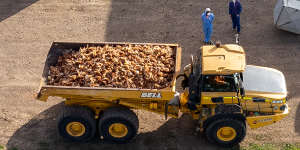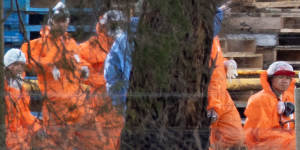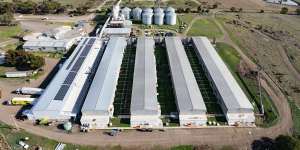The highly pathogenic H7N3 strain of avian influenza was discovered this week as the cause of several bird deaths at an egg farm between Ballarat and Geelong. On Thursday afternoon,Agriculture Victoria bird flu had been found at a second poultry farm near Terang.

The slaughter of 400,000 chickens is under way as Victoria tries to curb the latest avian flu outbreak.Jason South
The initial find came as a second human case of the deadly H5N1 strain of bird flu was discovered in a dairy worker in the US state of Michigan,transmitted by cattle.
The Victorian chickens at the centre of Australia’s first avian flu outbreak in four years were contained on Thursday in nine vast sheds on the Meredith property,linked by narrow outdoor spaces. Until last year,the farm traded as Moorabool Valley Eggs,before being sold and trading as AVGO Eggs. Happy Hens and Surf Coast Eggs trucks were also on the property on Thursday.
As busloads of workers arrived at the property,wearing hazmat suits and masks under the supervision of Agriculture Victoria officials,vehicles delivered dozens of large gas canisters.
Agriculture Victoria announced it had placed a five-kilometre cordon around the egg farm. It also imposed a broader control area buffer zone covering 20 kilometres around the farm.
This allows authorities to restrict the movement of poultry,poultry products,equipment and vehicles on or off properties in the area,and impose penalties on people who fail to comply with directions.
A road closure sign was placed on the road leading up to the farm,preventing access to the final 150 metres approaching the property.
Contact tracing was also under way to determine the source and spread of the infection.
Agriculture Victoria said a 1.5-kilometre cordon and a larger buffer zone of 15 kilometres had been implemented near the Terang outbreak,which it says is linked to the Meredith farm.

Workers prepare to kill the chickens near the town of Meredith.Jason South
The H7N3 strain of avian flu is different from the virulent strain of H5N1,which has been ripping through wildlife populations on every continent except Australia.
Fears the were sparked earlier this year whenand a dairy worker fell ill.
Sustained transmission of avian flu between humans has not yet been recorded.
Victoria’s Chief Veterinarian,Graeme Cooke,said the virus strain detected near Meredith was H7N3,as opposed to the H5N1 strain that has ravaged bird and mammal populations in the US and elsewhere.
“The current risk to the public remains low.”
Victoria’s Chief Veterinarian,Graeme Cooke
The deadly H5N1 variant was first detected in wild birds in Europe in 2020 and spread to birds in the US and Canada in late 2021.
More than 90 million birds and poultry have been infected with the H5N1 variant in the US since 2022,and it has killed thousands of Adelie penguins and skua seabirds in Antarctica. H5N1 has not yet been detected in birds in Australia.
“While cases among humans in direct contact with animals infected with highly pathogenic avian influenza viruses are possible,the current risk to the public remains low,” Cooke said.
Federal Agriculture Minister Murray Watt said while it was a relief H5N1 had not been detected,Australia took any instance of highly pathogenic avian flu seriously.
“Australia has effective,nationally agreed response and cost-sharing arrangements in place to address animal disease incursions and outbreaks,and this has swung into action to support Victoria,” he said.
“Australia is well practised in responding to disease incidents in poultry and has successfully responded to eight outbreaks of HPAI[highly pathogenic avian influenza] in poultry since 1976.
“In all those cases,we were able to eradicate the disease successfully and rapidly with minimal spread between farms.”
In Western Australia,biosecurity measures have been tightened on a poultry farm in the state’s south-west after the discovery of an unrelated strain of avian flu.

A highly pathogenic strain of avian flu was detected at the vast egg farm in Meredith.Jason South
Authorities say the strain detected in WA was a low pathogenic H9N2 strain and not connected to the Victorian outbreak.
On Wednesday,a child was confirmed as of the lethal H5N1 strain spreading around the world.
The child,who returned to Victoria from India in March,experienced a severe infection after contracting the strain,but had made a full recovery,Victorian Chief Health Officer Clare Looker confirmed.
Authorities say contact tracing has not identified any further cases.
With AAP,Lachlan Abbott and Marta Pascual Juanola
Start the day with a summary of the day’s most important and interesting stories,analysis and insights..